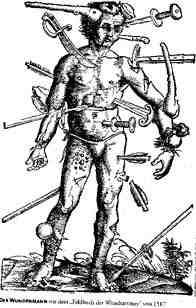Central Nervous System involvement in Pain Processing
Jurgen Sandkuhler (2000) Learning and Memory in Pain Pathways. Pain, 88, 113-118
- the brain can transform transient experiences into memories that have been attributed to long-lasting activity-dependent changes in synaptic strength
- use dependent long-term potentiation (LTP) of synaptic strength in the hippocampus, an area implicated in learning and memory
- LTP occurs in the cortex and spinal cord regions
- hyperlgesia and allodynia following trauma, inflammation or acute nerve injury are, at least partly, due to central sensitization (vs. peripheral sensitization of nerve receptors)
- activation of A delta and C fibres in the sciatic nerve have been implicated as a conditioning stimuli producing LTP
- onset and duration of LTP may be dependent upon the type and intensity of the conditioning stimulation and the activation of inhibitory controls - however in animals the duration of LTP has been shown to last a lifetime
- morphological, structural and gene related modification of synaptic connectivity suggest that early intervention may be more responsive to therapy
- these authors express some belief in TENS and electro-acupuncture
- additional personal conclusions from this and some other recent papers suggest that explanations to patients, reduction in peripheral hypersensitivity (i.e. contributing mechanical and physiological dysfunctions), cognitive strategies to prevent 'fear-avoidance' behaviour, and close liaising with the Medical practitioner are essential.
- less clear is the role of 'clinical reasoning' to this process i.e. do we just reinforce dysfunction rather than function?
- does 'clinical reasoning' help set realistic aims and objectives, clearly delineate what can and can't be done in terms of ADL?
- can 'clinical reasoning' help determine the level of preconditioning (e.g. establishing the number and duration of painful experiences in the past history, determination of the progression of primary and secondary hyperalgesia and loading tolerance in the current history as well as the aggravating/easing factors and 24 hour behaviour)?
- what frequency of electrotherapy or mobilisation may be of benefit when considering LTP
Martin Krause, March 2001
|
Der Wundenmann (1587)
|
Hsieh, J-C., Stahle-Backdahl, M., Hagermark, O., Stone-Elander, S., Rosenquist, G., Ingvar, M., (1995). Traumatic nociceptive pain activates the hypothalamus and the periaqueductal gray: a positron emission tomography study.
|
|
Pain and pain images are processed, realized and actualized in the central nervous system (e.g. brain & spinal cord)
See more PET imaging of pain in the brain
|
|




























































































































